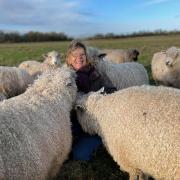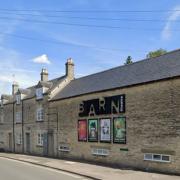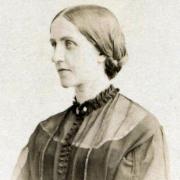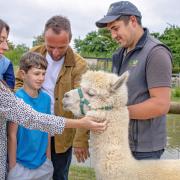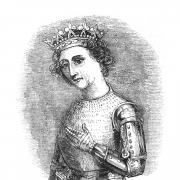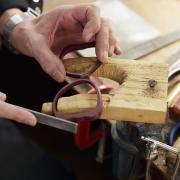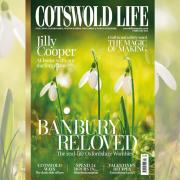The team at Gloucestershire Archives dust off the documents to discover some of the county's most fascinating characters...
Farm workers during haymaking
Despite the rip through the original, you can almost smell the hay and hear the buzz of the insects in this evocative photograph showing a group of farm workers relaxing in a meadow during haymaking. It could have been taken anywhere in the county at anytime in the last 180 years or so, but this particular image is thought to have been taken just below the Cotswold escarpment around Cam in the 1890s. As a hay-rake is just visible (far right) it seems that the grass had been cut a day or so before and it is now being turned (tedded) to help dry it before being taken to the farm for storage. Focusing in on ‘Grandad’ with his magnificent beard and straw hat, you can see some wonderful details. Perhaps the most exquisite – and one which is almost always unseen in photographs – are the hobnails on the men’s boots. Notice also that there are several white china tea-cups visible – although judging by the big stoneware bottle in wicker coverings, it’s unlikely that the cups held tea!

PC James Stafford
In 1906, the long arm of the law in Withington was PC James Stafford – seen here with his wife Esther Mary and their two sons, William (left) and Frank (right). James was born in Elberton in 1869 and was a labourer who joined the Gloucestershire Constabulary on April 11, 1892, aged 23. He was 5ft 10” tall and remained a constable throughout his career, retiring with a full pension on March 31, 1919. We know this from the ‘Alphabetical register of rural constabulary’ (GA Ref.No: Q/Y/1/1) at Gloucestershire Archives which gives names and careers of all county police officers from 1839-1919. The family are standing in the doorway of Withington police station, which closed in June 1916 – with one report on it stating ‘The premises are old and in indifferent repair. They comprise one room washhouse pantry and old dilapidated room on the ground floor and two bedrooms over a tolerably secure lock up. There is a great want of privacy at the back yard, water and privy being common to other houses and the sewage defective.’ One imagines the Staffords were glad to leave!

Samuel Clark of Slimbridge
Samuel Clark – seen here wearing the bowler hat – looks every bit like the head of the family he was in this wonderful photograph. It was taken around 1903, probably after the christening of the babies – certainly everyone appears very smart and the men are sporting button holes. Samuel’s wife, Angelina (or Annie, as she was more commonly known), is sitting in the centre. Prior to their marriage, while he was a cowman in Slimbridge and she was a dairymaid in Berkeley, Samuel wrote regularly to Annie. The letters are wonderful and although they mainly deal with the couple’s arrangements to meet, they frequently refer to local events such as weddings, travelling fairs and entertainments in the Berkeley and Slimbridge areas. As anybody who has taken family portraits knows, keeping everyone still is a hard task and was even more difficult in past times with more primitive camera equipment. While the two babies are slightly blurred and so have obviously moved, the black Labrador at the far left has remained motionless – one wonders what the cameraman had to do to keep its attention!

Stroud Urban District Council firemen
This photograph shows Stroud Urban District Council’s fire engine, with four firemen and a policeman. A postmark on the back gives a posting date of August 28, 1910, so it was taken prior to that date and possibly after attending a fire. The pump is a horse-drawn double-vertical boiler engine made by London firm Merryweather & Sons. It could pump between 250-400 gallons a minute but was steam-powered, so the boiler had to be lit beforehand. This took 10 minutes, but the fire could be started before leaving the fire station so there was generally enough pressure by the time the engine arrived at the fire. The main issue with these appliances was that they required a water source, so it was essential to find a pond or a lake if no other source was available. All the girls love a fireman and it was no different in the past – look closely and you’ll notice a ‘X’ marked against the fireman on the left. This card was sent by an unknown girl to her friend, and the rear of the postcard is endorsed with the note ‘I have put a cross by the one I am going to meet tonight. You wonder whether it was a successful date!

Mrs Watkins with daughter, Emmie
This photograph shows Mrs Watkins and her daughter Emmie harvesting in the fields of Forthampton around 1905. The couple were photographed by the Vicar of Forthampton’s daughter, Ms Amy Walters. Harvest time was an ‘everybody-in’ activity and whole villages would come together to help to get the crops in, which is why these two were out in the fields. Census records tell us that Mrs Watkin’s Christian name was Fanny and she lived with her husband Richard at Mill Hill in Forthampton. Richard was a ‘cowman’ and he probably worked for the adjacent Mill Hill Farm. Like her husband, Fanny had been born just over the border in Queenhill, Worcestershire. She was 39 years old when the photograph was taken and the couple had three other children, all girls; Ethel (aged 16), Edith (aged 14) and Elsie (aged 12) – they obviously liked first names beginning with the letter ‘E’! Fanny lived to the grand old age of 82, not passing away until 1945. What is wonderful about this image is that it captures details not often seen – such as Fanny’s cap, belt, blouse buttons and little Emmie’s boots.

Landlord and landlady of the Yew Tree Inn
This formidable looking couple, photographed circa 1865, are the landlord and landlady of the Yew Tree Inn at Wall’s Quarry on Brimscombe Hill. They appear in a set of five photograph albums entitled ‘My Parish and Congregation’ compiled in the 1860s and 1870s by the Rev Edward Blackwell, vicar of Amberley. The albums include general views of the church and churchyard, the vicarage and Rev Blackwell's family, as well as portraits of individuals and families from the area. The first volume is entitled ’Clergymen who have ministered at Amberley’ (which include the Rev Francis Close, rector of Cheltenham and later Dean of Carlisle, as well as some ethnic African and Asian missionaries), while the second is ‘My Friends’ (and includes the Rt. Hon. W. E. Gladstone MP). The remaining three volumes are all called simply ‘My parish and congregation’. The photographs within the albums are all captioned and at times very detailed, providing dates, relationships and locations, plus all manner of interesting snippets of information. They are a reminder for all of us to date and caption our own images be they digital or hard-copy!

Mr James Wood
This fantastic photograph shows Mr James Wood, road roller inspector in Gloucestershire County Council's surveyor's department, on an LMC motorbike in the Gloucester council depot sometime around 1914. The registration plate number 0 4517 reveals that the motorbike was registered in Birmingham, which makes sense because the LMC or Lloyd Motor Engineering Company was based in Ladywood, Birmingham. They built motorbikes from 1903 to 1922 and, depending on the model, they cost from around £50 up to £80, being produced in solo, touring, low-frame and sidecar versions. This version boasts two speed chain and belt drive for low and high speed running respectively. The company’s 1910 advertising makes reference to a special ‘novelty’ on one of its models; ‘a pillion seat with footboard, rail and guard for a lady passenger’! Given his role as a road roller inspector, one can imagine that Mr Wood was a common sight riding his motorbike around the county visiting roadworks, although one doubts whether he ever took a lady passenger with him.
Gloucestershire Archives, Clarence Row, Alvin Street, Gloucester, GL1 3DW, email: archives@gloucestershire.gov.uk, gloucestershire.gov.uk/archives
Follow on Twitter: @GlosHeritageHub
SUBSCRIBE to Cotswold Life magazine to learn more about this area's heritage.









